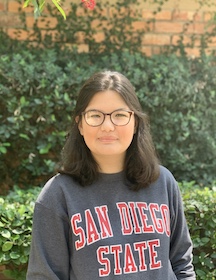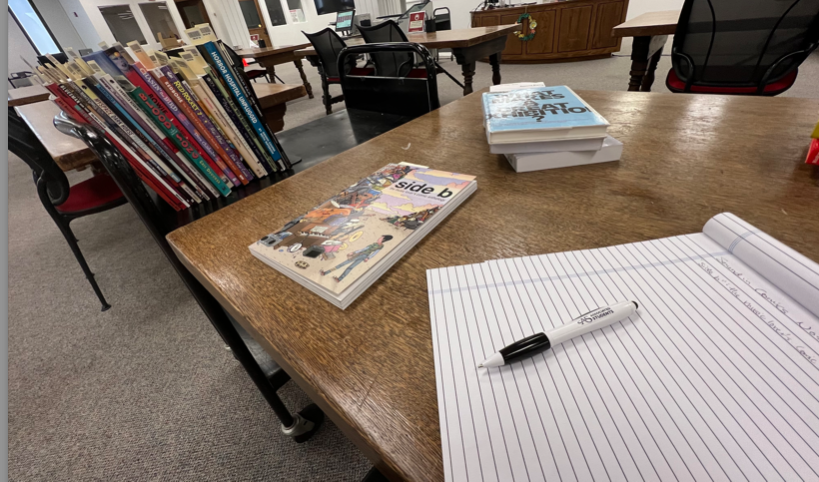Written by Grace deVega
SDSU History Major, 2022
All comic heroes need a compelling origin story: Spider-Man with Uncle Ben, Batman with his parents in the alley, or the Teenage Mutant Ninja Turtles with the toxic waste in the sewers. These beginnings shape their characters and lay the foundation for the rest of the series. For exhibits, the beginning stages of curation serve a similar purpose, especially when it comes to sourcing the materials for the collection. These sources serve as both the basis upon which the exhibit will make its argument and the catalyst that compels patrons to interact.
You could say I am on my personal Ninja-Turtle-and-toxic-sewer-waste origin story journey, albeit without the superpowers and affinity for pizza, as I begin to curate materials for my exhibit on depictions of sound in comics. Now that I have completed the bulk of the background research, my main focus has been on sourcing examples from a variety of places. Throughout this process, I have learned how to broaden my approach to sourcing and to tackle topics from multiple, and often new, angles.
If the Teenage Mutant Ninja Turtles’ superhero origins stories revolve around an love for pizza, mine would certainly revolve around music. As someone who has both performed in ensembles for many years and conducted previous research on depictions of music in sequential art, I decided to start the curation process with locating materials for the music category because it was a topic with which I was most familiar. Because this exhibit is being developed in coordination with the Center for Comics Studies, I plan to have nearly all of the materials come from SDSU and, more specifically, the comics in the Special Collections that can be found via the SDSU Library’s ComicsHub. I learned early on that the sheer number and variety of comics that SDSU offers meant that I needed to quickly narrow my field in order to find comics about music. In order to achieve this, I created a list of keywords related to music and then began to search for comics that included those words in their titles and synopses. Such words included “band,” “concert,” “instrument,” “singer,” “piano,” “guitar,” and “drums.” From there, it became a process of reading through the selection for any references to music in their imagery, symbols, content, plotlines, and characters. At the same time, I relied on secondary scholarship, namely peer-reviewed articles, that discussed music for further examples. It was, in a sense, a sort of reverse engineering where I relied on the secondary material to find primary evidence that I could then look for and include in my own research. Both of these types of sourcing were invaluable in helping me curate a variety of comics that feature music in different forms.
I then moved on to explore comics that feature onomatopoeia, or words formed from the sound with which they are associated, such as bang, zap, and pow. Whereas music in comics is often plot or character specific, onomatopoeia and sound effects are found in nearly every comic in some capacity, so it is difficult to search by keywords. As such, I had to adapt my process for setting search parameters. One of the easiest ways to limit the comics was to search by national origin. I hope to analyze onomatopoeia in comics across languages and nationalities in the exhibit, so looking through the foreign-language comics that SDSU possesses was a simple but effective way to both find evidence and narrow down the searches. In terms of English-language comics, I provided the repository with specific time period and publisher parameters so that I could curate a cross-section of what I believed represented the different genres, eras, styles, and artists from the collection. The intention behind this search was to use these comics as starting points for finding trends or patterns of onomatopoeiae that I could then go back and look for in the ComicsHub. For example, based on the various noir-style comics that I pulled in my initial search, I found these types of comics often forgo flashy forms of onomatopoeia for the sake of style. Therefore, if I need further evidence of noir-style onomatopoeia or of subtle uses of sound effects in the future, I can search for them in the repository based on the criteria set by these original noir comics. I am still in process with looking for onomatopoeia, particularly in unusual or novel forms, but breaking down the ComicsHub into manageable pieces has been helpful in setting a baseline for my continued research.
In addition to these efforts in the ComicsHub and Special Collections, I have also ventured into sourcing via other means than traditional database mining. Recently, I crowdsourced my question via Twitter, reaching out to the comics scholars that collaborate on that platform. My tweet received substantial engagement from academics that shared their personal and classroom encounters with onomatopoeia in comics. I was surprised by the level of interaction, as well as the specificity of answers. Additionally, it was fascinating to watch the reach of the tweet expand over the course of several days as it became liked and reposted by scholars across the country and even the globe.
Beyond diving into the digital sphere, I took a physical venture into new sourcing avenues by touring the Comic-Con Museum in Balboa Park, San Diego. All of my other exhibit tours have been virtual, so the Comic-Con Museum offered a fresh perspective on showcasing comics in museum settings. The museum currently features an exhibition on the history and cultural impacts of Spider-Man and includes several different digital displays and activities. I was particularly intrigued by a sound booth that plays the original Spider-Man song through a set of ear pieces. I found many examples of comics that I hope to explore further, as well as learned new comics organization techniques and ways to integrate interactivity into exhibits.

Throughout this entire research journey, one of the most surprising aspects has been the fact that this type of curation does not follow a linear path. In contrast to what I believed going into the work, there is no fixed set of steps where one article would lead to an example of a specific comic and that comic would then be sourced and added to the collection. Instead, it is an iterative process: a series of backtracking, starting over, and jumping from idea to idea, which creates a long, complicated, and often cyclical flow of scholarly discovery. Exploring this is an exciting path of research just one of the many lessons I have learned and will continue to learn throughout my academic adventure into the aural.

Grace deVega (she/her) is a Fourth Year History and Political Science student at San Diego State University. She previously won the President’s Award at the SDSU Student Research Symposium and 1st Place in her Division at the CSU Research Competition for her research into the impacts of the 1986 Philippines People Power Movement on nonviolent revolutions. She has also played clarinet for the past twelve years, including in the SDSU marching and concert bands, which is where her passion for music and aural studies derives.









